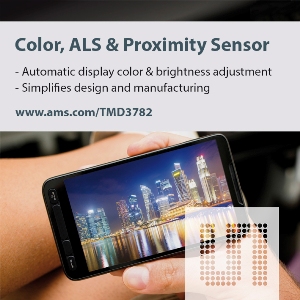May 13 2014
ams AG, a leading provider of high performance analog ICs and sensors, today announced the industry’s first integrated ambient light, color (RGB) and proximity sensor that is optimized for operation behind dark glass to drive intelligent display adaption in mobile devices.
 PA TMD3782 Color Sensor
PA TMD3782 Color Sensor
The TMD3782 optical module is ideally suited for smartphones and tablets. The sensor integrated in the TMD3782 provides ambient light intensity (lux) and color measurement enabling mobile devices to automatically adjust their display’s color and brightness for the best viewing experience and power savings.
High-resolution displays are now standard features in mobile devices, making it critical they provide accurate colors and brightness while operating in a wide range of light sources, including fluorescent, incandescent and sunlight. The TMD3782 on-chip filters minimize the effects of ultra-violet and IR light and enable its photopic response thus improving the overall accuracy of light and color sensing.
Enhancing the user’s viewing experience across a wide range of lighting conditions offers mobile device manufacturers new means to draw consumers to their brand. The TMD3782 is able to sense light in a similar manner to the human eye, enabling more sophisticated control of the display brightness and color. The combination of ambient light and color sensing enables mobile devices to deliver more brilliant display colors and a superior viewing experience in all lighting environments.
“The adoption of the TMD3782 by manufacturers validates the industry trend of increasing intelligence in display management in smartphones and tablets,” said Darrell Benke, Senior Marketing Manager for optosensor products at ams. “Consumers will choose devices which provide the best user viewing experience through automatic adjustment of display color as well as brightness.”
The TMD3782 packs the ambient light, color and proximity sensor, IR LED and optical lenses in a 3.9 x 2.4 x 1.4mm module suitable for mounting in the densely populated and low-profile board assemblies commonly found in mobile devices. The sensor’s integrated proximity sensor can be used to simplify a product’s user interface, for instance, supporting intelligent on/off control of smartphone touchscreens. The device’s integrated proximity sensor also allows tablets to eliminate false ambient light sensing measurements by detecting when the user’s hand or finger is blocking light from reaching the sensor. The proximity detection is factory-calibrated to a distance of 100mm, eliminating the need for OEMs to perform production-line calibration, and simplifying end-product manufacturing.
The TMD3782 sensor’s photodiodes have a radial structure to create a uniform and optimized angular response when mounted under the 360° module lens. The sensor also provides a 45 degree field of view for a broader and more accurate measurement of the lighting environment. An interrupt capability enables the sensor to alert the applications processor when pre-set light and color measurement thresholds are crossed, eliminating the need for continuous polling and reducing overall system power requirements and hence extending battery life.
Price & Availability
The TMD3782 optical sensor module is in volume production and is priced at $1.45 for 1,000 pieces.
Technical Support
An evaluation kit for the TMD3782 is available online. For further information please visit www.ams.com/Color-Sensor/TMD37821.
Source: http://www.ams.com/